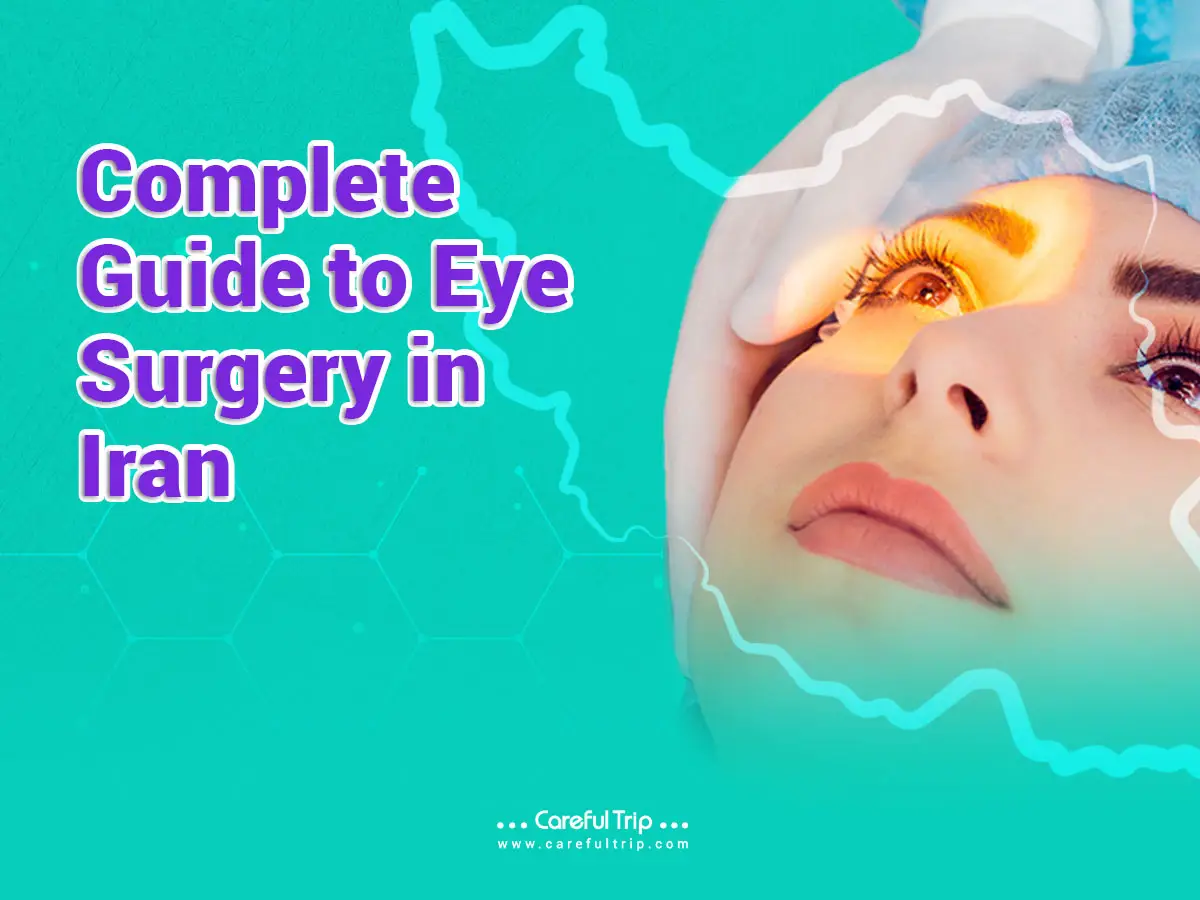
The eyes are the organs responsible for the visual system, allowing organisms to receive and process visual details and respond accordingly. Vision, however, is not the sole purpose of the eyes. They also detect light and convert it into electrochemical messages, enabling the brain to process images. Understanding the range of treatments available for vision correction and eye health is essential given the critical importance of eyes.
Eye surgery, an integral part of ophthalmology, offers solutions for various eye disorders. With advancements in technology and highly skilled specialists, Iran has emerged as a global leader in offering state-of-the-art eye surgery services. Here, we will give detailed insights into the types of eye surgery available in Iran, the conditions they treat, and why Iran is the preferred destination for many patients worldwide.
For more information, read:

What is Eye Surgery?
Eye surgery is performed by an ophthalmologist to treat various eye conditions or improve the visual system’s function. It involves examining the eye and its adnexa, such as the eyelids, eyelashes, lacrimal gland, and drainage apparatus. These structures play an essential role in protecting the globe, lubricating the eye, and minimizing infection risks. Ophthalmologists choose the appropriate surgical method based on the eye condition and provide the necessary aftercare.
While references to eye surgery date back to the 5th century BC, significant advances have been made over the centuries, especially in modern times, to address various eye problems. Iran, with its history of contributions to the field of ophthalmology, continues to lead the way with groundbreaking treatments.
For more information, read:
Why Choose Iran for Eye Surgery?
Iran has been at the forefront of ophthalmology in the Middle East for decades, renowned for its advanced medical technology, modern treatment facilities, and highly skilled ophthalmologists. As one of the top 15 countries globally for ophthalmic scientific and technological advances, Iran consistently ranks high in the field of eye care.
Iran’s ophthalmology centers are equipped with the latest medical technologies and provide a wide range of services, including LASIK, PRK, Phemto LASIK, cataract surgery, and more. CarefulTrip, a leading medical tourism facilitator, ensures that patients receive the best care by partnering with trusted and internationally recognized surgeons.
The affordability of eye treatments in Iran is another major draw, with costs typically much lower than in other countries. This combination of quality care and affordable pricing has made Iran a popular choice for individuals seeking vision correction or treatment for various eye conditions.
Common Eye Problems and Their Treatments
1. Glaucoma
Glaucoma refers to a group of eye conditions that damage the optic nerve, often caused by high intraocular pressure. If left untreated, glaucoma can lead to irreversible blindness. Iran offers treatments like eye drops, laser therapy, and surgical procedures to slow or halt glaucoma’s progression. Early detection is critical for managing this condition.
Symptoms:
- Mild headaches
- Blurry vision
- Difficulty adjusting to light changes
- Frequent changes in eyeglass prescription
2. Cataracts
A cataract is a clouding of the eye’s lens, leading to impaired vision. Cataracts are commonly caused by aging but can also result from trauma, diabetes, or medication side effects. In Iran, cataract surgery is highly advanced, with the procedure involving the removal of the cloudy lens and its replacement with an artificial intraocular lens (IOL).
Symptoms:
- Blurred vision, especially in bright light
- Difficulty driving at night
- Faded colors and difficulty recognizing faces
“In most cases, waiting to have cataract surgery won’t harm your eye, so you have time to consider your options,” – Mayo Clinic
For more information, read:
3. Macular Degeneration (AMD)
Age-related macular degeneration (AMD) is one of the leading causes of vision loss among those over 60. It affects the macula, the central part of the retina, which is responsible for sharp, direct vision. In Iran, AMD is treated using vitamin supplements, laser therapy, and anti-VEGF injections to manage the progression of the disease.
Types:
- Dry AMD (atrophic): Gradual deterioration of the macula.
- Wet AMD (exudative): Abnormal blood vessels leak fluid, leading to rapid vision loss.

4. Retinal Detachment
Retinal detachment is a medical emergency and occurs when the retina separates from the back of the eye. This condition requires urgent surgical intervention to avoid permanent vision loss. Iran’s skilled ophthalmic surgeons are experts in managing retinal detachment with laser therapy, vitrectomy, or scleral buckling.
5. Refractive Errors
Refractive errors such as myopia, hyperopia, and astigmatism can be corrected with refractive surgery options like LASIK, PRK, and Phemto LASIK. These procedures reshape the cornea to correct vision, reducing or eliminating the need for glasses or contact lenses.
For more information, read:
Types of Eye Surgery in Iran
1. LASIK & Phemto LASIK
LASIK (Laser-Assisted in Situ Keratomileusis) is a popular and highly effective refractive surgery to correct myopia, hyperopia, and astigmatism. In Iran, Phemto LASIK is a modern variant that uses a femtosecond laser for improved precision and faster recovery.
2. PRK (Photorefractive Keratectomy)
PRK is an alternative to LASIK where the outer layer of the cornea is removed before reshaping it with a laser. This procedure is ideal for patients with thin corneas or high degrees of refractive error.
3. Retina Surgery
Surgical options for retinal conditions such as detachment or macular holes include vitrectomy, laser treatment, and scleral buckling. Iran is home to some of the best retina specialists globally, offering cutting-edge care.
4. Corneal Transplantation
Corneal transplant (keratoplasty) is often performed for patients with keratoconus or other corneal diseases that cannot be treated with contact lenses or medication.
For more information, read:
Reconstructive Eye Surgery Options
1. Blepharoplasty
Blepharoplasty, or eyelid surgery, is a reconstructive procedure that addresses drooping eyelids, eyelid deformities, and cosmetic concerns. It can improve vision in cases where excess skin obstructs the field of vision, in addition to enhancing the appearance of the eyes.
2. Iris Implants
Iris implants are gaining popularity for cosmetic and medical reasons. This procedure involves the implantation of a colored artificial iris to correct congenital or acquired iris defects, or to change the eye color permanently. Iran is a leading provider of artificial iris surgery through specialized clinics such as Noor Hospital.
For more information, read:
Why Choose CarefulTrip for Eye Surgery in Iran?
CarefulTrip offers comprehensive assistance for those traveling to Iran for eye surgery. The services include:
- Pre-Surgery Consultation: Personalized advice to help you select the best ophthalmologist and clinic.
- Travel Support: Help with visas, flights, and accommodation arrangements.
- On-Site Care: Multilingual coordinators to assist with local navigation and cultural differences.
- Post-Surgery Care: Ongoing support, including follow-up consultations and rehabilitation services.
With high success rates, affordable treatment costs, and top-tier medical professionals, Iran remains an attractive destination for international patients seeking eye care. CarefulTrip ensures that your journey is as smooth and seamless as possible.
For more information, read:
Final Words
Eye surgery in Iran offers advanced solutions to a wide range of vision and eye health issues. With highly skilled surgeons, cutting-edge technology, and affordable prices, Iran remains a top eye care destination. Whether you’re considering LASIK, cataract surgery, or a more specialized procedure like retina surgery or iris implants, Iran offers world-class medical care. Contact CarefulTrip today to get started on your eye surgery journey with the best ophthalmologists and clinics in Iran.

Sources
- American Academy of Ophthalmology – LASIK Surgery Overview
- Mayo Clinic – Cataract Surgery and Recovery
- World Health Organization – Eye Health and Vision Care
- Iran Health Tourism News – Advancements in Ophthalmology in Iran
For more information, read:
